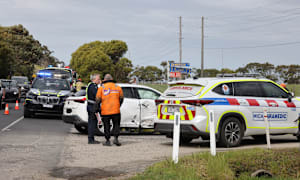IT WAS more about protection and less about retreat as the Department of Energy, Environment and Climate Action (DEECA) and the Cape-to-Cape Resilience Project team continued to soften their language around the response to Inverloch’s erosion problems at an online seminar last Thursday night, October 16.
One of the 30 questions put to the panel during a probing Q&A, which followed the Inverloch Dune Reconstruction Works Information Session, directly addressed the emotive issue of retreat, that is, a planned fallback from at-risk coastal areas.
Cassandra Philippou, Cape to Cape Resilience Project Manager responded.
“Look, I know that retreat has been something that has popped up fairly frequently during the project and for the resilience plan as well. Retreat is really a process of managed land use transition. It doesn’t happen instantly. It’s something that takes place over a long period of time and is planned.
“And the idea is that we need to change the way we use places and land so that we can put more appropriate uses in those places that are less vulnerable to some of those coastal hazards.
“So, the managed transition in the adaptation pathway for the Surf Beach is really to be activated in the medium to long term. So, we’re not talking tomorrow. We’re not talking in five years’ time. It’s really looking at having that transition really moving along by about 2070 or the 0.5 sea level rise scenario.”
Darrin McKenzie, DEECA’s Gippsland regional director chimed in saying that while initial community consultation, in early 2021 (based on 180 surveys, 38 per cent from Inverloch residents) provided the basis for the strategy, he was open to the idea of re-assessing community desires and goals in the future.
“What Caz has said is right, there’s work happening in government to try and understand what the implementation of a retreat policy would look like, and this comes back to comments I was making about community values, and it has to be a community-driven plan.
“When we put the first draft out for consultation, we got quite a bit of feedback from members of the community saying it was too focused on retreat. That there was some ideological position in government that that’s the pathway we wanted to go down. That’s certainly not the case,” said Mr McKenzie.
“So, we have responded to that feedback, and once the final plan comes out, you’ll see in there, the community will see that we’ve introduced an additional pathway that does provide a greater emphasis, or opportunities for protective type outcomes into the future.
“That’s not to say that the work we’ve been talking about today, in terms of the dune reconstruction and renourishment, is not a protection pathway for us. We are looking to protect the dunes and ultimately protect the assets that sit on that coastal zone.
“It is a nature-based, or a natural-based protection pathway or action for us.”
Bass Coast Shire Councillor Meg Edwards, who watched the seminar with a group of people at home last Thursday evening, said she felt community action had moved the needle from talk about retreat to protection, which was heartening.
“Honestly, I think that just basing your response on 180 submissions when 2500 people signed a petition, 700 attended a beach rally and 350 at a town hall meeting, calling for greater protection, does indicate a wider spread of opinion,” said Cr Edwards.
“The word ‘protect’ came up a lot more and there was also the offer to go back and test community sentiment again,” she said.
“What was also interesting is that the limits being placed on the amount of sand they’re prepared to move and dunes they’re prepared to reinstate is based more on the limits to the funding rather than what’s needed to do the job.
“If it’s actually going to cost $10 million to complete the work, the government should look at the economic and social benefits and fund it upfront.”
Cr Edwards said she was also concerned the sand dredging and dune reinstatement works would be carried out in the period between February and Easter, still a busy time on the beach at Inverloch.
President of the Inverloch Surf Life Saving Club, Glenn Arnold, was also pleased to hear the commitments being made to protecting rather than retreating.
“We’re pleased to hear that they’re going to go ahead and extend the sand-bag wall (east and west of its present position) and that they’re going to get that work done before Christmas,” said Mr Arnold.
“And that the sand dredging and dune reinstatement work will commence in February, followed by the revegetation works.”
Mr Arnold said he also raised the potential of using jute mesh, made from natural products or Coir mesh made from coconut husk fibres, to protect the dunes and assist in the revegetation process as a possible solution.
Mr McKenzie said there would be a similar online information session held later to advise the community about the exact timelines for work and how that might impact activities on the beach and in the town.
Some of the other questions addressed such issues as how long the dune reconstruction and replanting program would provide protection for houses and other assets, what the impact had been of recent storms and high tides, who would be responsible for releasing stormwater from Wreck Creek, the impact of dredging on Anderson Inlet, who would respond in an emergency and why hard engineering options weren’t being used.
Among those who presented at the online seminar were:
* Darrin McKenzie, Gippsland regional director Department of Environment, Land, Water and Planning
* Elise Lawry, coastal engineer at Water Technology Pty Ltd
* Simon Woodland, manager sustainable environment at Bass Coast Shire Council
* Jeremy Neilson, regional manager for Land and Built Environment (DEECA).










